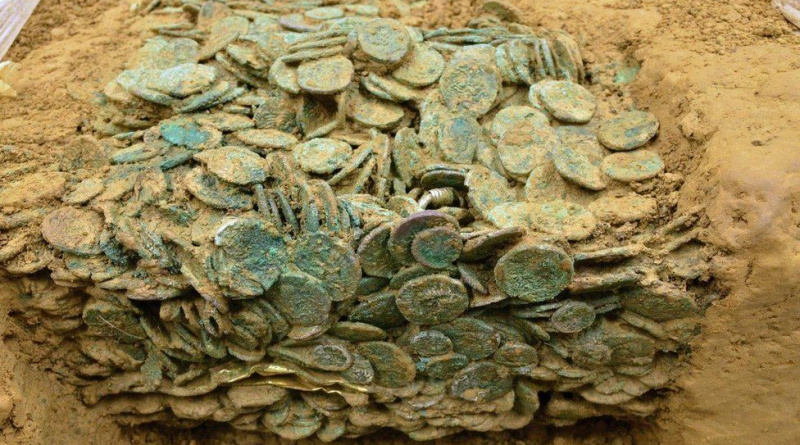Le Câtillon II hoard bought by Jersey government for £4.25 million
Le Câtillon II is the largest coin hoard found in the British Isles. It was discovered by detectorists Reg Mead and Richard Miles in 2012, after a 30 year quest. This week it was announced that the /Government of Jersey has purchased it “on behalf of the island” for £4.25 million.
The find
A chance conversation
Reg and Richard heard began detecting in the early 1980s and heard about a farmer who had discovered some coins in a earthenware pot. Reg told Tony Livesey of Radio 5 about the initial lead in 2012 “A very good friend of ours, we were having a meal one weekend and she said “Oh, you do metal detecting, I’ve got an interesting story ‘when I was a young girl, my father was farming this area and he was pulling an old hedgerow down … and he pulled out from the roots of a tree a clay pot full of silver coins”. You can hear more of Reg’s fascinating interview at Reg Mead tells Tony how he found one of Europe’s largest hoards of Iron Age coins.
Thirty year quest
Following that lead, the pair began a thirty year quest. As they did not know the exact location of the find and they were only allow them to metal detect once a year for 10–15 hours (after the crops had been harvested) by the current owner, it took about 30 years before they eventually managed to locate the hoard. In February 2012, they finally secured permission to detect in a new field in Grouville. On the second day of searching, Richard’s device let out a recognisable zapping sound.
They contacted the head of Jersey Heritage, who later helped arrange for an excavation team, and a crane, to help dig one ton haul of around 70,000 coins over four days in the summer of 2012.
The hoard comprised thousands of coins fused together into a block measuring 140cm by 70cm by 15cm and it was decided to excavate it intact in a single block. This BBC report of the find shows how it was done.
The hoard
The hoard contained 69,347 coins as well as some jewellery, including a number of gold torques. The hoard also included leather and cloth items, including this leather purse shown after conservation and a fabric bag that was found to contain gold and silver jewellery.
The hoard has been linked to the Coriosolitae tribe who lived in Armorica, in modern Normandy. Most of the coins were cleaned only enough to allow identification, due to the sheer number that the hoard contained.
Purchase of the hoard by the Jersey government
The find was claimed by the crown as treasure in 2012. Since then there have been wranglings over the valuation of the hoard. After nine years, on 17 December 2021, they agreed a £4.25 million price. The Government of Jersey has paid this using money from the civil asset recovery fund, which is money recovered from criminal activities. This will be split between Reg and Richard, the land owner and Jersey Heritage for cleaning the coins.

